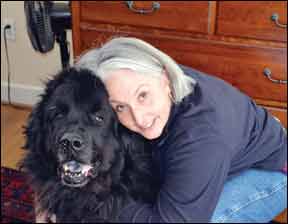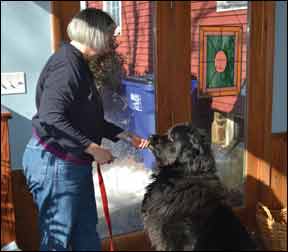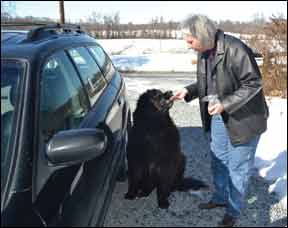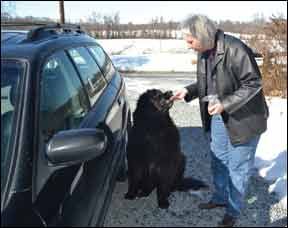Behavior issues, from simple good manners infractions to the more concerning problems of phobias and aggression, appear in dogs both large and small. But while training to modify behavior issues might look the same regardless of size, in other respects, the bigger the dog, the bigger the problem. When a Dachshund has a lapse in housetraining, the cleanup process is significantly easier than if an Irish Wolfhound has an accident. If a Havanese frantically jumps up on your elderly Aunt Tilly, the collateral damage is less than if a Great Dane does the same. And if a Yorkie is terrified of riding in the car and refuses to get in for an emergency trip to the vet, he can be picked up and placed inside – not so when a Newfoundland steadfastly refuses.

288
What do you do with a giant breed dog who, at the slightest hint that a car ride is imminent, runs to the farthest room in the house, lies down, and won’t budge? Such was the case of Igor, a six-year-old, 165-pound Newfoundland.
Igor’s fear of the car had gotten progressively worse over his lifetime. Elizabeth, Igor’s owner, received advice and a prescription for an anti-anxiety medication from her veterinarian. But an incident that could have been a matter of life or death prompted her to seek a referral from her vet for a behavior professional.
There were three other dogs living at the house when Elizabeth woke to a puppy playing with an empty prescription bottle. Was the puppy the one who ate the pills, or did one of the other dogs empty the bottle and leave it behind for the puppy to play with? It was clear that all four dogs needed to be taken to the veterinary clinic to be examined and the contents of their stomachs emptied. Three dogs were quickly loaded into the car, but Igor refused. All of the luring, cajoling, dragging, and shoving in the world would not convince Igor to enter what he perceived as a torture chamber. Fortunately, one of the other dogs was the culprit in this pill-eating incident, but it was enough to convince Elizabeth that something had to be done before she was possibly faced with another life-threatening emergency.
The origins of fear
A dog’s fear of the car may be rooted in one or several different unpleasant associations developed when riding in a vehicle. The sound and vibration of the engine alone can be frightening to a puppy. The situation may be exacerbated by confinement in a small space with no way to escape. Many dogs experience car sickness as puppies, and even though they may outgrow it, the unpleasant association with physical illness remains. A dog may associate car travel with going to unpleasant destinations, such as the veterinary clinic or groomer, where he is poked, prodded, stuck with needles, or gets his nails trimmed. A car accident can be a traumatic experience for a dog and may lead to an intense fear. Or a dog may experience discomfort jumping into or out of the vehicle as a result of a medical condition such as arthritis or hip dysplasia.
Pinpointing the origins of Igor’s fear could help in working up a comprehensive training plan. It wasn’t likely that unpleasant destinations caused the problem; he actually seemed to enjoy his vet visits once he was at the clinic.
Physical discomfort entering and exiting the car was probably not the issue, either; Igor hoisted his large body onto the couch daily. He had never experienced a car accident. Perhaps the sound and vibration of the engine had frightened him as a puppy, or maybe motion sickness had caused his negative association. Whenever Igor was riding in the car, he hung his head between the back seat headrests and stared out the rear hatchback window. It appeared to be his attempt to visually limit motion.
Igor had shown signs of being uncomfortable in a car since he was a puppy, but his fear escalated after a round trip drive from Maryland to Tennessee when he was two years old, and over time he became more reluctant to enter the car. At first, Elizabeth was able to lure him into the car with a pig ear as a reward. Eventually, Igor figured out this trick, and would bolt across the yard when he realized he was being guided to the car. Elizabeth then started taking him to the car on-leash and forcing him into the car. Soon the leash became useless; Igor would use his massive weight to pull Elizabeth in the opposite direction. Living in an old farmhouse on several acres and rarely walking on-leash, Igor quickly associated the appearance of the leash to being taken to the car. Elizabeth approaching him with the leash became a cue for him to run to another room and lie down. When a 165-pound dog decides not to budge, there isn’t much you can do about it!
Getting help
Elizabeth consulted her veterinarian, who prescribed the tranquilizer Acepromazine (“Ace”) to help with Igor’s problem. Commonly prescribed by veterinarians for pets who experience anxiety during car travel, Ace produces sedation and suppresses behavior (normal and abnormal), and decreases locomotive coordination. The medication also reduces nausea and vomiting in animals who experience motion sickness.

288
Research has also shown that while Ace functions as a chemical restraint, it does not affect the animal’s emotional behavior. While under the effect of the drug, the animal may be unable to physically react to what triggers the fear, even appearing calm and relaxed, but may still be having an intense emotional reaction.
Veterinarian, behaviorist, and psychopharmacology expert Dr. Karen Overall states that Ace “works by disassociative effects, meaning that you could still perceive the stimulus, but you can’t cognitively put it together . . . you’re aware of what’s happening to you, but it doesn’t make any sense to you . . .” (This quote is from Leashes to Neurons & Psychopharmacology, a DVD of a lecture given by Dr. Overall in 2007 and a terrific resource for owners and trainers who want to know more about medications that can be used to treat abnormal canine behavior.)
If the animal is still terrified and confused, but is physically unable to react, negative associations and fears may be amplified, potentially making the problem even worse. If the fear level intensifies, the animal may even break through the chemical restraint, overriding the physiological effects of the drug. In addition, according to Dr. Overall, Ace heightens sensitivity to noises – not a desirable effect when working with a dog who already has a negative association with the sound of a car engine.
Elizabeth began to administer Ace to Igor one to two hours prior to car travel as prescribed. In his sedated state, she was now able to lead Igor to the car without much resistance. When they arrived at the car door, Elizabeth would throw treats on the back seat, place Igor’s paws in the car, and shove him in from behind. Igor was still fearful, just unable to physically resist with as much strength. After the pill-eating incident, it became evident that using Ace was not a solution. There is no time to wait for one to two hours for Ace to take effect in a medical emergency so she could shove him into the car.
In January 2010, Elizabeth’s veterinarian referred her to me to help with Igor’s fear of the car.
Meeting the gentle giant
The Igor I met was a sweet, affectionate, gentle soul, and with the exception of his fear of the car, had no other behavior issues of concern. Elizabeth clearly loved him, but had no clue as to what it would take to improve the situation. As many owners mistakenly assume, she believed that Igor was simply stubborn. It never occurred to her that he was actually terrified and miserable. This revelation during the consultation saddened Elizabeth; how could she have forced the dog she adored into a terrifying situation for so many years? She was eager to help Igor overcome his fear.
Igor’s fear of the car had a long history. We discussed what it would take to change his emotional response to riding in the car from one of terror to one of enjoyment, or, at the very least, calm acceptance. It was important to prevent Igor from having to ride in the car during the training, so I recommended veterinary home visits and a mobile groomer.
We reviewed the general training protocol needed to help Igor and talked about the amount of time it could take to see improvement, as well as the long term commitment that would be required of Elizabeth. She later admitted feeling overwhelmed and discouraged after our initial meeting. To her credit, she made the commitment to do the work necessary to help her beloved Igor conquer his fear – no matter what, or how long, it took.
Beginning at the beginning
Counter-conditioning and desensitization (CC&D) is considered the most effective method in working with fears, anxieties, and phobias. Our goal was to change Igor’s emotional response to riding in the car from negative to positive. To use counter-conditioning, we needed to pair something Igor perceived as wonderful (in his case, garlic hot dogs and cheese) with the scary things that triggered his fear response. We also needed to work below Igor’s fear threshold, at a level of intensity low enough to avoid a fearful response, gradually increasing the intensity in small increments as long as Igor stayed relaxed (desensitization).

288
Before we actually could work with Igor in or around the car, we had to get him to the car. We began training at the point where he first became anxious about the prospect of having to go for a car ride. The leash draped over the kitchen chair, or even hanging around Elizabeth’s neck as she behaved normally in the house, elicited no signs of stress from Igor. If Elizabeth approached him with the leash he retreated. If I held the leash, Igor wasn’t particularly interested, so we began with me presenting the leash to him a couple of feet away. When the leash appeared, Igor got to graze on a handful of garlic hot dog bits. When the leash disappeared behind my back, the yummy treats disappeared as well. Soon Igor was looking to me when the leash appeared, as if to say “Yay! Hot dogs, please?” This was the conditioned emotional response (CER) that we look for in counter-conditioning; he was beginning to associate the leash with good things instead of bad.
Gradually I moved the leash closer with each trial. The process went very quickly; Igor never showed any signs of stress, even when we switched places and Elizabeth began presenting the leash. By the end of our first session we were both able to clasp the leash onto Igor’s collar as he remained calm and relaxed. To further desensitize Igor to the leash, Elizabeth left the leash on him periodically while he slept, ate, and walked around the house. He didn’t seem to mind one bit.
In subsequent sessions we continued using both CC&D and rewarding behaviors leading toward our goal of getting Igor to the car. We started by walking Igor inside the house on-leash. We played games, practiced “sit” and “come” with a clicker and treats, and gradually began training near the door that led to the driveway. By the end of one session of leash practice, the leash had become a cue for fun!
Elizabeth continued the training between our sessions, and very soon Igor willingly went outside on-leash. Since the car was parked straight ahead in the driveway, we quickly veered left into the yard and walked, clicking and giving him treats and praise on our way around the entire house, past the car, and back inside. Eventually, instead of passing by the car, we stopped next to it, briefly practiced some sits, gave treats and praise, and continued back to the house. Throughout the process we were careful to observe Igor for any visible signs of stress and moved forward only when Igor was relaxed.
Making contact
Once Igor was comfortable working in close proximity to the car, we tried a couple of different techniques to get him to actually make contact with the vehicle. Igor carried a lot of weight on his frame, was considered a senior dog for his breed, and more of a couch potato then a canine athlete. We needed to conserve his movement so that we could maximize his progress in training sessions and prevent any negative association by being overworked, tired, or sore. So we continued to use CC&D to gradually open the door to the back seat with Igor sitting near the door.
At that point, it was time to try to reward Igor for his calm behavior with the door open by placing his hot dog bits on the threshold of the car door. Lo and behold, we had contact! Soon Igor calmly approached the car when lured with treats, and soon after that he approached the car just in anticipation of being given treats.
Once Igor would happily eat treats from the car doorway, Elizabeth began to feed Igor all of his meals in that location. He readily followed her to the car for his food bowl and calmly ate his meals. But when we tried to gradually move the food bowl farther inside the car, he became hesitant. His meals consisted of dry kibble only, so we tried adding a little canned food with warm water mixed in. The results of “Igor’s special sauce” were amazing. It wasn’t long before Igor was willing to get his entire body into the car to eat his meals, and would even run to the car in anticipation of his gourmet meal and leap in the back seat – well, as close to leaping as a 165-pound dog is able!

288
Gradually, we were able to close the car door while he ate and open it only when he finished. Elizabeth began to sit in the driver’s seat with the door closed while Igor ate. She had faithfully worked with Igor for about three months at this point, and she could finally see a glimpse of light at the end of the tunnel.
Rev your engines!
The next step of turning the ignition key was a big one. Elizabeth started giving Igor melatonin an hour prior to training sessions to help him remain relaxed. A naturally produced hormone, melatonin can reduce stress levels without causing drowsiness if given at the proper dosage.
With Igor finally entering the car willingly for treat rewards, we once again used CC&D to help him accept the sound of the ignition, the vibration, and the hum of the engine for longer and longer periods. Since Elizabeth would be doing most of the training with Igor unassisted, we needed to figure out a way she could logistically and safely feed Igor while starting the engine and moving the car.
Enter the cheesy spoon! Elizabeth used a long handled wooden spoon smeared with yummy canned squirt cheese. She offered the spoon to Igor between the front seats with one hand as she turned the key in the ignition with the other. The first time he heard the engine, Igor was startled, but the cheesy spoon quickly had his full attention. Over time, Igor remained calm in the car with the motor on with only occasional treats and lots of proud praise from his mom.
We were finally ready to start moving! Although Igor never threw up in a moving car, we decided to err on the side of caution in case he did experience motion sickness. He was given powdered ginger root in capsules prior to training to help keep his tummy calm, and we never trained him when his stomach was full.
Get the show on the road
The cheesy spoon is not necessarily the method of food presentation I would recommend for a driver doing counter-conditioning on busy roads. But fortunately, Elizabeth and Igor live on a rural country lane with few houses. When Igor was comfortable with the engine running, it was time to move the car. Elizabeth began to back up the car a few feet while presenting the cheesy spoon. Then she would stop the car, remove the spoon for a few moments, then move the car forward and present the spoon again.
Practicing two to three times a week, Elizabeth used this procedure to progress to the end of the driveway, then drove a very short distance down the lane, and finally drove to the end of the lane (a tenth of a mile). Igor was rewarded with dinner at the end of these brief excursions, as well as lots of hugs, kisses, and praise. Elizabeth said he always looked very proud of himself!
Training stalled in late spring. The combination of a big black dog, rising temperatures, and a black leather car interior made it unsafe to continue, so Igor had a summer vacation from the car. Once fall arrived and the temperatures were more reasonable, Elizabeth began feeding Igor his meals in the car again, and resumed their brief trips down the country lane. In time, these trips went as far as the mailbox (a quarter-mile from the house), and eventually to the stop sign at the end of the road – about a mile and a half each way. The cheesy spoon was gone, and periodic treats were enough to keep Igor calm.
Leap of faith
One rule of CC&D is to never exceed the comfort level or fear threshold of the dog during training. Moving too far too fast is a common mistake of those new to the process. It can be painstakingly slow at times, and owners often become impatient hoping for quicker results.
Elizabeth was extremely patient and worked hard to help Igor to the point where he was calm in the car riding for short distances. But one day last fall, she decided to throw caution to the wind. She loaded Igor and her other dog Abby into the car, and drove to a McDonalds, a full seven miles away! My heart dropped when she told me about the trip – until I heard the details.
Elizabeth drove slowly, feeding treats to Igor and Abby at every stop sign and red light. She ordered an Egg McMuffin at the drive-thru window, parked the car, and fed half of the sandwich to a happy Igor and Abby. They continued home and were rewarded with the other half of the McMuffin when they arrived. Would I have suggested this significantly longer trip at this stage of the training? No, but it worked out fine. And as long as Igor doesn’t become a fast food junkie, an occasional Egg McMuffin excursion is really not a bad idea.
Achieving the goal
It’s been over a year since I first met Igor, the Newfie who ran at the sight of a leash for fear of riding in the car. And it’s been about six months since his successful 14-mile round trip for an Egg McMuffin. Does Igor now love car rides? No, but he usually tolerates them calmly. He’s had occasional relapses when pushed too far or too long, acting more reluctant when asked to get in the car for the next trip. But Elizabeth is now aware when she has pushed his limits, and knows to step back in training. Her commitment to helping Igor is the single biggest reason for his success.
There are only winners in this story. As long as he can walk to the car, Elizabeth never has to worry about not being able to get Igor to a vet in case of emergency. Igor no longer is terrified of anything. And I got to help the world’s sweetest Newfie and his wonderfully committed mom make a big problem go away.
Susan Sarubin, CPDT-KA, lives in Easton, Maryland, with her husband and three Rhodesian Ridgebacks. She owns Pawsitive Fit, LLC, Puppy and Dog Training, and is the Maryland State Coordinator for Rhodesian Ridgeback Rescue, Inc.






